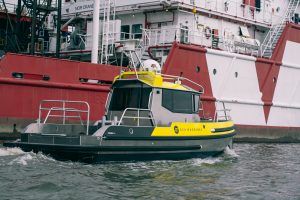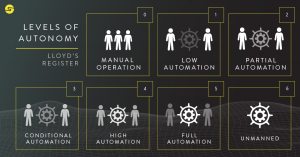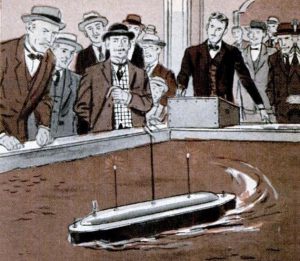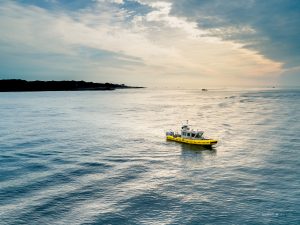Uncategorized The Ultimate Guide to Maritime Autonomy in 2024
January 15, 2024
In the dynamic realm of maritime technology, autonomy stands out as a true game-changer.
Stay up-to-date on the latest advancements, practical applications that change your bottom line, and the trajectory of autonomy in this Ultimate Guide to Maritime Autonomy in 2024.

Autonomous vessels can lighten the human workload by taking over tasks that are dangerous, dirty, or dull.
What is Maritime Autonomy?
Maritime autonomy refers to how vessels can operate and navigate with varying degrees of human involvement. This capability can be included in a new ship’s design or retrofitted to existing vessels through an external processor and software, such as the SM300 system.
An autonomous maritime vessel can take the form of an underwater vehicle, known as a UUV (Unmanned Underwater Vehicle), or operate on the water’s surface.
Smaller vessels operating without a crew on board are often termed an USV (Unmanned or Uncrewed Surface Vessel), while larger ships with a crew are usually categorized as MASS (Maritime Autonomous Surface Ships).
The integration of autonomous technologies and systems empowers ships, boats, and other maritime platforms to execute a diverse range of tasks autonomously, such as long-range routes, over 500NM, planned broad area survey/search grids, and collision avoidance. For a detailed list of examples showcasing autonomous capabilities, browse our dedicated page here.

The Levels of Autonomy, per Lloyd’s Register
Levels of Autonomy
Autonomy is not a singular concept. It spans a wide array of capabilities, from operations that are remotely controlled by a human operator, much like a toy car, to full autonomy where decisions are made independently by an onboard processor and software without human intervention.
There are numerous industry standards that define the levels of autonomous capabilities. However, the most widely accepted standard is the Lloyd’s Registry’s levels of automation, which range from 1, representing the lowest level of autonomy, to 6, denoting full automation.
For more information on the levels of autonomy, click here.

Tesla’s radio-controlled boat, AKA the first USV.
The Evolution of Maritime Autonomy: A Timeline Snapshot from 1898-2023
1898: In Manhattan, NY, Nikola Tesla debuted the world’s first USV, a 4 ft. long radio-controlled boat.
1945: In the aftermath of World War II, the US Navy pioneered the use of remote-controlled USVs for target drone and minesweeping applications.
2016: Hosted by the Royal Navy, autonomy took a significant step forward during Exercise Unmanned Warrior , showcasing the potential of autonomous technologies.
2018: Sea Machines marked a milestone by introducing our SM300 Autonomous Command and Control system, marking one of the first commercially available systems that can be retrofit to existing vessels.
June 2021: The MSC (The International Maritime Organization’s Maritime Safety Committee) greenlit Interim guidelines for MASS trials, emphasizing the growing acceptance and regulation of autonomous technologies.
October 2021: Sea Machines achieved a groundbreaking remotely-commanded autonomous navigation feat with The Machine Odyssey, covering 1,000 nautical miles around the coast of Denmark with 96.89% of the journey autonomously executed.
2022: Sunflower Shiretoko autonomously sailed 750 km. on a commercial shipping route, showcasing the expanding capabilities of autonomous maritime systems.
2023: DNV and Samsung Heavy Industries announced a collaborative effort on the development of a Remote Operation Centre for autonomous ships, further highlighting the industry’s commitment to advancing autonomous capabilities.

Deep BV’s SM300 equipped autonomous survey vessel can be remotely commanded from shore, allowing for the management of navigation, positioning, on-board auxiliaries, sensors, and the flow of data between the ship and shore.
Everyday Autonomy
Autonomy is already present and hard at work in the maritime industry. Below is a closer look into how autonomy is currently being applied in different sectors.
Shipping Revolution
Waypoint following emerges as a pivotal element in the shipping revolution, allowing containerships to traverse the most efficient routes. This not only reduces fuel usage but also curtails carbon emissions. (Read more here). Simultaneously, the incorporation of collision avoidance mechanisms acts as a robust safeguard against ship collisions, mitigating the potential loss of life, cargo, and environmental damage, such as oil spills resulting from collisions (Link to oil spill incident).
Hydrographic Survey
Autonomy in hydrographic surveys streamlines costs by allowing personnel to work remotely and bill for the specific time required. This not only fosters efficiency and significant cost savings for specialized workers and survey agencies but becomes especially vital during times of personnel shortage, reshaping traditional survey practices.
Utilising autonomy can also contribute to more efficient survey grid operations by eliminating the need for grid overlap, resulting in reduced time on the job and lower fuel consumption.
SAR (Search and Rescue)
Equipping SAR vessels with autonomy, especially in conjunction with a Computer Vision system as seen here https://sea-machines.com/product/ai-ris-computer-vision-center/, is a groundbreaking step in detecting and rescuing targets in the water, especially in sea conditions where it may be unsafe to deploy traditional manned vessels.
Environmental Monitoring Advancements
Autonomy is an exciting step forward for environmental monitoring at sea. Unmanned vessels equipped with advanced sensors contribute to ongoing efforts in monitoring ocean conditions, detecting pollution, and safeguarding marine ecosystems.
Defence Dynamics
With faster deployment times and lower operational costs, autonomy is a crucial asset in surveillance, reconnaissance, and strategic operations.
In the defence sector, unmanned vessels can act as a force multiplier allowing for multiple smaller vessels to patrol an area, rather than one large. As well as allow for remote controlling of smaller vessel for launching and recovery as seen here in a demonstration of the SM300 with the USCG.
The Next Phase
In 2024, we can expect autonomy to become even more widespread as a solution to seafarer shortages across multiple industries.
According to a report by Drewry, the shortfall of officers has reached a record high, nearly doubling from about five percent a year ago to nine percent of the global pool. This is the highest level since Drewry first started analysing the seafarer market 17 years ago. . Autonomy provides a solution by allowing for a leaner crew.
While the adoption of autonomy is rapidly being accepted as a useful addition to the mariner’s tool kit, there is still there is still a transitionary phase towards achieving full acceptance from various stakeholders, particularly international regulatory bodies such as the International Maritime Organization (IMO).
In many instances, the deployment of unmanned vessels is permitted with explicit authorization from the respective national authorities within territorial waters. Nevertheless, when it comes to international waters or major trade routes regulated by the International Maritime Organization (IMO), the integration of autonomy awaits the establishment of comprehensive regulations specifically tailored for MASS.
With its last meeting in 2022, the IMO has made progress on developing a flexible framework outlining the overarching objectives and standards that these vessels should meet for safe and effective operation, with aims of having a non-mandatory MASS code to take effect in 2025 that will pave the way for a mandatory MASS Code expected to be completed by 2028.

Conclusion
The realm of maritime autonomy has evolved significantly, leveraging advanced technologies to enhance efficiency and safety in marine operations. The year 2024 marks a pivotal point as the maritime community grows to accept newer additions to the mariner’s repertoire.
Real-world applications, spanning shipping, SAR, and survey, demonstrate the practical benefits of autonomy. Yet, challenges in regulations demand attention.
Looking forward, the future holds promise. Ongoing technological progress and collaboration set the stage for a seamlessly autonomous maritime landscape.
Don’t be the last to embrace autonomy. Our Autonomous Command and Control system, the SM300, is available to be retrofitted on vessels of any size. Book a demo to see autonomy in action here.
Follow us on our socials for the latest updates in the world of autonomy and more!